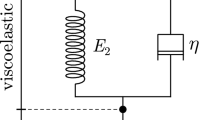Abstract
A test method to determine fracture energy and strain-softening in direct tension is described. Experimental results on cylinders of equal diameter and varying length are reported. It is found that the tensile strength decreases with increasing volume while the fracture energy remains constant within the observed volume range. By means of numerical simulation, it is shown that in a direct tension test several fracture process zones appear in the initial states of cracking and that final rupture is induced by the development of only one of these fracture zones. This phenomenon has been observed experimentally by other authors. A comparatively large number (44) of identical samples were tested by using the wedge-splitting test. Half the specimens were grooved. The fracture energy of the grooved and ungrooved specimens turned out to be the same within the given range of accuracy. It was observed experimentally and simulated numerically that in grooved specimens the crack is forced to follow a ragged fracture surface which is statistically not the weakest one. In an ungrooved specimen the crack path generally diverts from the centre line and advances through weaker zones. For the formation of these skew cracks, however, more energy is consumed due to aggregate interlock. In addition, the fracture process zone observed in ungrooved specimens is generally wider.
Resume
Dans cet article, on décrit une méthode expérimentale permettant de déterminer l'énergie de rupture et le diagramme de radoucissement d'une éprouvette sollicitée en traction directe. On donne les résultats expérimentaux obtenus sur des éprouvettes cylindriques de même rayon mais de longeur variable. On a trouvé que la résistance à la traction décroît lorsque le volume augmente alors que l'énergie de rupture conserve une valeur constante dans la gamme des volumes considérée. On a montré par simulation numérique que plusieurs zones d'endommagement apparaissent à l'état initial de fissuration; cependant, la rupture finale est induite par le développement d'une seule de ces zones d'endommagement. Ces phénomènes ont aussi été observés expérimentalement par d'autres auteurs. Un nombre relativement grand (44) d'éprouvettes identiques ont été essayées par la méthode de l'essai de fendage par coin. La moitié de ces spécimens sont pourvus d'une rainure le long de leur ligament. Il s'est avéré que l'énergie de rupture est la même pour les éprouvettes rainurées et non rainurées ceci à la précision des mesures près. On a observé, aussi bien expérimentalement que numériquement, que dans les éprouvettes munies d'une rainure, la fissure est contrainte de suivre une surface de rupture effilée, qui n'est pas statistiquement la plus faible. Dans le cas d'éprouvettes non rainurées, la chemin de la fissure dévie généralement de la ligne centrale et progresse vers les zones les plus faibles. Ces fissures qui obliquent nécessitent cependant une plus grande consommation d'énergie à cause du mécanisme de l'engrenage inter-granulaire. En plus, la zone d'endommagement observée sur les éprouvettes non rainurées est généralement plus large.
Similar content being viewed by others
References
Alvaredo, A. M. and Wittman, F. H., ‘Crack formation due to hygral gradients’, in ‘Fracture Mechanics of Concrete Structures’, edited by Z. P. Bazant (Elsevier, 1992) pp. 960–966.
Idem, Alvaredo, A. M. and Wittman, F. H., ‘Shrinkage as influenced by strain softening and crack formation’, in ‘Creep and Shrinkage of Concrete’, edited by Z. P. Bazant and I. Carol (E & FN Spon, 1993) pp. 103–113.
Idem, Alvaredo, A. M. and Wittman, F. H., ‘Stability and crack formation under hygral gradients’, in ‘Numerical Models in Fracture Mechanics of Concrete’, edited by F. H. Wittmann (Balkema, 1993) pp. 251–263.
Freudenthal, A. ‘Statistical approach to brittle fracture’, in ‘Fracture’, edited by H. Liebowitz (Academic Press, 1968), pp. 591–619.
Hordijk, D. A., Reinhardt, H. W. and Cornelissen, H. A. W., ‘Fracture mechanics parameters of concrete from uniaxial tensile tests as influenced by specimen length’, in Proceedings SEM/RILEM Int. Conference on Fracture Mechanics of Concrete Structures, Houston, Texas, pp. 138–149.
Slowik, V., ‘Influence of size of specimen and strain gradient on the experimentally determined fracture energy’, in ‘Numerical Models in Fracture Mechanics of Concrete’, edited by F. H. Wittmann (Balkema, 1993) pp. 41–53.
Brühwiler, E. and Wittmann, F. H., ‘The wedge splitting test, a new method of performing stable fracture mechanics tests,’Engng Fract. Mech. 35(1/2/3) (1990) 117–125.
Slowik, V., ‘Beiträge zur experimentellen Bestimmung bruchmechanischer Materialparameter von Betonen’, Research Report No. 3, Institute for Building Materials, Swiss Federal Institute of Technology Zurich, 1993.
Luong, M. P., ‘Infrared vibrothermography of plain concretes’ in ‘Fracture Toughness and Fracture Energy of Concrete’, edited by F. H. Wittmann (Elsevier, 1986) pp. 249–257.
Raiss, M. E., Dougill, J. W. and Newman, J. B., ‘Observation of the development of fracture process zones in concrete’, in ‘Fracture of Concrete and Rock: Recent Developments’, edited by S. P. Shah, S. E. Swartz and B. Barr (Elsevier, 1989) pp. 243–253.
Breysse, D. and Schmitt, N., ‘A test for delaying localization in tension. Numerical interpretation through a probabilistic approach’,Cem. Concr. Res. 21 (1991) 963–974.
Berthaud, Y., Ringot, E. and Schmitt, N., ‘Experimental measurements of localization for tensile tests on concrete’, in ‘Fracture Processes in Concrete, Rock, and Ceramics’, Vol. 1, edited by J. G. M. van Mier, J. G. Rots and A. Bakker (E & FN Spon, 1991), pp. 41–50.
Wittmann, F. H., ‘Fracture process zone and fracture energy’, in ‘Fracture Mechanics of Concrete Structures’, edited by Z. P. Bazant (Elsevier, 1992) pp. 391–403.
Author information
Authors and Affiliations
Rights and permissions
About this article
Cite this article
Wittmann, F.H., Slowik, V. & Alvaredo, A.M. Probabilistic aspects of fracture energy of concrete. Materials and Structures 27, 499–504 (1994). https://doi.org/10.1007/BF02473209
Issue Date:
DOI: https://doi.org/10.1007/BF02473209




